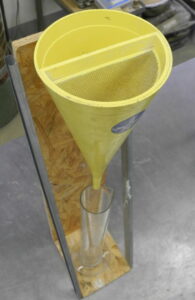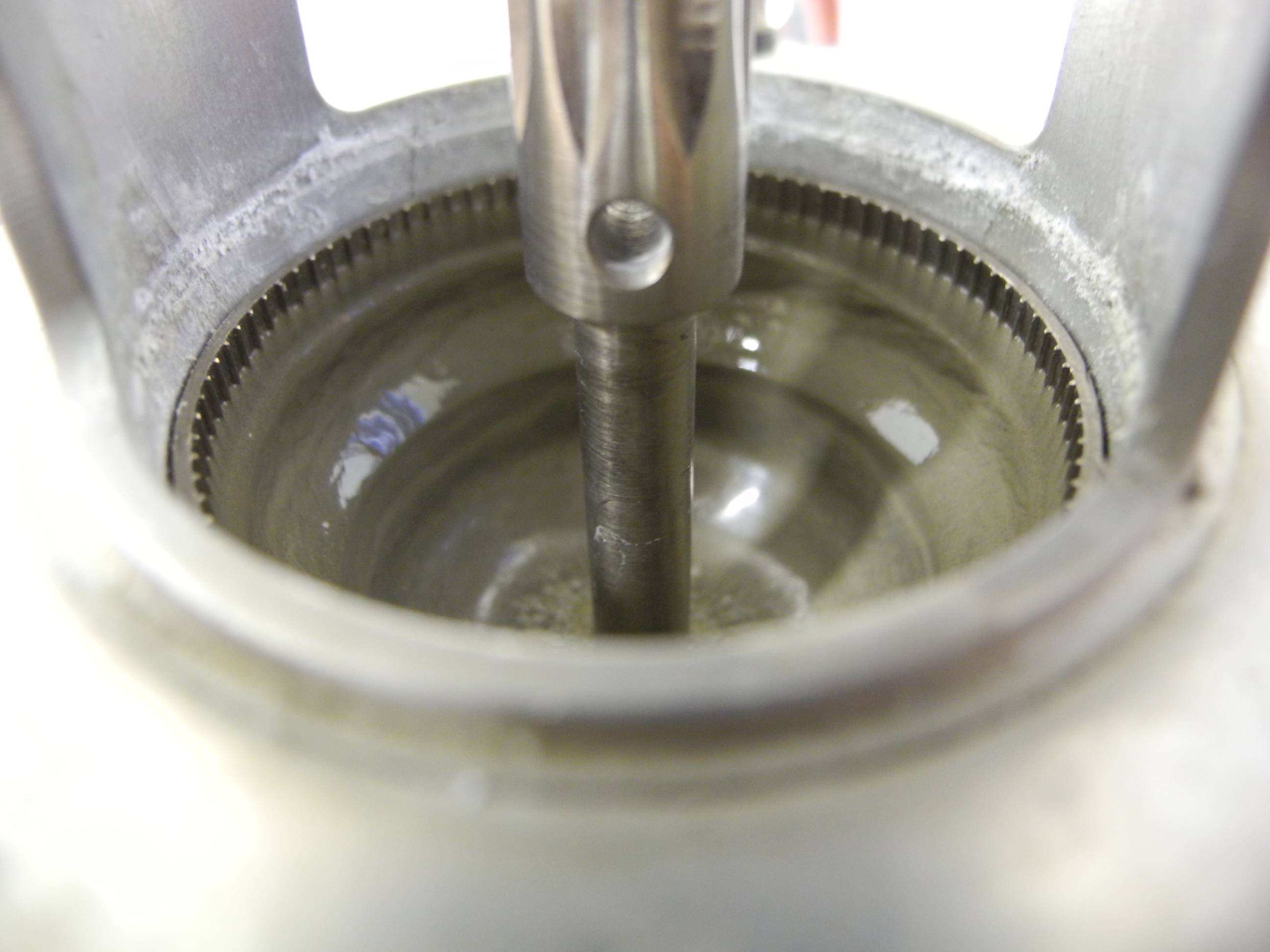Or: what makes a good grout– quality assurance in grouting technology
High-tech kitchen, new pots, shiny pans and even a zucchini pasta cutter. Also a family recipe that makes your mouth water simply by reading – but what is it good for if maggots are in the flour and free range eggs know the free range only from advertisements? No matter how much work you invest in a cake, in the end Gordon Ramsay will still say: back to the start!
It’s the same story in ground engineering when it comes to grouting into the ground. From low pressure injections to blasting injections, the concept of grouting technology covers a broad spectrum with one commonality: a grout is pressed into the subsoil.
Similar to pastry, there are good and bad grouts (actually you could say that there are only good and very good cakes (and both my grannies‘ cakes, which are in regards to taste situated on both sides of the spectrum)). To find out what really makes a good grout we talked to Adrian Kainrath, expert for grouting material, who researched on quality criteria and assurance for grouting technology for his dissertation. In this blog the expert for grouting material explains in detail how this quality assurance works.
Eggs and lard, sugar and salt
As is commonly known, you need seven ingredients for a cake – but you only need three for grouting:
First, a predefined grouting goal (hence, the choice of the cake: shall it be a black-forest cake, or rather a carrot cake?). So for example, whether the subsoil should be lifted or sealed.
Second, a good grouting concept – comparable to a cake recipe. This tells you for example in which distances the sleeve pipes should be drilled, which pressure is needed and the grouting sequence.
Third, a grouting material – and that’s our focus today. “The material has had a bit of a pansy existence”, says Kainrath. True to the motto “out of sight, out of mind” the grouted material in the subsoil had little importance in the last decades. However, it is of tremendous significance for every grouting project what material is used for the subsoil treatment. To stick with pastry metaphors: organic eggs or free range eggs? Wheat flour or spelt? How much baking powder do I need and how about a dash of rum for a better taste?

The agony of choice
“It used to be that every construction firm had a standard mixture that was used for all injections, regardless of the ground and subsoil conditions” explains Kainrath. If it didn’t work with this recipe, another material was used or the injection continued until any reaction was visible.
Nowadays, the product variety has increased vastly and the construction firms can choose between different cements. A suspension mixture of water and cement, enriched with additives that change the properties of the material (viscosity, consistency, resistance, hardening time, etc.) and the grouting process. Different water qualities can result in different properties of the base mix at different locations (just compare the taste of Viennese tap water and chlorinated water in the swimming pool).
To avoid that these different properties and characteristics negatively impact the construction, every mixture is tested on its suitability.
Third time lucky
“Because it’s something that is heavily depending on the parameters on site, it is important to have an evaluation concept and a clear assessment”, Kainrath emphasises. Here as well it is third time lucky, this evaluation is built up in three steps:
First, the principle check is done by the cement producer. The data of the mixture (ingredients, mixing ratio, …) are noted on the product sheet.
Second, suitability test is carried out by the construction company. After deciding on the suitable cement, it is mixed with additives and water to test the mixture on its properties. “You want to have a certain viscosity for example” Kainrath mentions, “so that the grout does not run off into the ground. Or when there is strong water rush, I need additives that prevent the injection from rinsing.”
Third, verification assessments are done directly at the construction site. “Properties that were determined in the laboratory are now tested on the field” Kainrath explains. “This test is reduced in input as the main focus lies on the actual grout. It is reduced to the main KPIs and is a simple check that should reaffirm the data from the laboratory.” Also, problems can only be dealt with at a later time, so the first two steps have to be carried out with particular care. Once the cake is in the oven, it is too late to add cinnamon. The difficulty lies in maintaining the test intensity so that errors are detected quickly, but the operation is not stopped by constant testing. It makes sense to check more frequently at the beginning and to reduce the intensity as soon as you can see that the quality can be maintained, he explains.

Digital instead of rustic
“Until now the problem is that assessment methods are rather outdated. The grouting technology is very old, and the level of the past was dragged into present time. For example, viscosity is still sometimes measured with a Marsh-funnel”. In this antiquated method, a funnel is sealed, filled and then –voilà- the finger is pulled away. Then you measure the time it takes for the liquid to drain and the funnel is empty again. “That worked in the 50s but today you have binding material and highly specialised injections gels. A funnel has not enough significance and validity.”

While quality assurance is still somewhere between ‚antique‘ and ‚from the previous century‘ on the average construction site, at some (most larger) sites more emphasis is put on digitisation. “It comes down to the client”, knows Kainrath.
In the future it would need to happen that currently manual checks are automated and the resulting information is transferred to a database. “That’s where the gap to eguana is closed.” SCALES gives an overview of construction projects and measurements during the construction progress. In a joint project the system is adapted so the tests and the KPIs can be recorded, evaluated and presented digitally. “No problem – because the collection of different data is our specialty.”
Here Kainrath sees the future of quality assurance: “On the one hand in good test methods, which offer comparable characteristics, and on the other hand in a data collection, so that I immediately see outliers and faulty batches. The buildings are getting bigger and more complex and the methods have to go along. The future must go in the direction of digitisation and automation in order to adequately ensure the quality of increasingly complex buildings.”
In the end, even Gordon Ramsay might be happy.
*****
Many thanks to Adrian Kainrath for this blog. We are looking forward to future exciting projects for quality assurance in the grouting technology!
*****
Guest author: Adrian Kainrath
Adrian Kainrath is an expert in the field of grouting material. He studied civil engineering with specialisation on hydraulic engineering and geotechnical engineering and was already working for well-known construction and engineering companies like STRABAG or ZÜBLIN during his studies at the TU Vienna. Afterword’s he worked as research assistant at the institute for geotechnical engineering in the area of grouting and can look on a long list of scientific publications. Now he works for Tschernutter Consulting GmbH in the field of dam construction and is a self-employed consultant for grouting technologies.
In his spare-time he likes to go hiking or on long ski tours (apparently you can take the Styrian from the mountain, but not the mountain out of the Styrian). Instead of month long trips to South America, India, Burma, Indonesia etc., for which he had time during his studies, he is now satisfied with camping trips to Croatia – also beautiful.
His passion for all construction site relevant was passed on already to his two-year-old sun with whom he spends time watching excavators at work.
Photocredits: Adrian Kainrath
